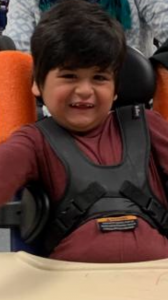 Currently, if you say hi to Joey he will quickly respond, “My name is Joey. I am five years old. My birthday is in February. I live in Virginia. Where do you live? Do you have any pets?
Currently, if you say hi to Joey he will quickly respond, “My name is Joey. I am five years old. My birthday is in February. I live in Virginia. Where do you live? Do you have any pets?
As he said, his birthday is coming up, and he is turning 6. What does a six year old look like?
Being a former first grade teacher, six year olds may be my favorite. (But then again, I say that about every developmental stage!)
As a child nears six, he often goes through what could be called a “behavior regression”. Chip Wood, author of Yardsticks, writes, “Although many of the characteristics of five carry over as children move toward six, increasingly unsettled behavior signals growth and change.” He notes that older fives tend to become more “oppositional, not sure of whether to be good or naughty”, can be insecure with their feelings, and test authority and limits more than they previously did. Older five year olds tend to become physically restless and tire quickly, work quickly, “make lots of mistakes, and recognize some of them.” Handwriting tends to regress, as the older five is trying to keep up with their fast thoughts. Children at this age need more physical activity and relaxed, free play, with even shorter work periods than younger fives.
When I was a special education teacher for kindergarten and first grade classes, I would often see this change in children. The students who could sit so quietly and comply with directions in kindergarten often showed more movement and questioning of their teachers when they came to first grade. It was not that a first grade teacher was suddenly lenient – just that the children were experiencing this developmental growth.
This older-five developmental stage is important to note, and to keep in mind that although development happens in a sequence, it also may follow different time-periods. Children just turning six may be experiencing the older five year old developmental patterns.
So what does six look like?
According to Chip Wood, six year olds are competitive, enthusiastic, may be “bossy”, and may invent rules to enable themselves to win. They love jokes, may complain frequently, and love learning through discovery, asking questions, and enjoy the process more than the product.
So where does Joey fall? It is no secret that Joey loves telling jokes, likes to engage with others, and can be enthusiastic about learning and games.
Lately, we have noticed some changes in how Joey approaches his work that correspond perfectly with the older five, six year old patterns. Joey is moving faster with his words, and less likely to pause and look at us when we talk with him. While he has almost never been oppositional, there are times he has been lately, as though he is testing what it is like to push back against authority. He is also moving so fast on his words lately that he does not seem to be noticing his mistakes (as those older five year olds do) and seems to be enjoying the process of using his device rather than paying attention to the product of communication.
What does that mean for my work with Joey?
As with any six year old, it is a good time to set limits and enforce boundaries. We will find times when he can quickly select words and share his rapid thoughts, and times when we will slow down and become more engaged. I need to remember to allow for breaks in our work to fit that older five-new six pattern of needing more movement and engagement. Just because Joey used to sit quietly and politely for my books and lessons does not mean that he is not going to experience the same developmental growth others his age do – and begin to push back just as typical six year olds might.
This is an excellent reminder to honor his age and development. We’ll celebrate his turning six, his developmental growth, and continue to set high expectations for him to meet.
Happy Birthday Joey! We are so thankful you are patient with us as we learn how to best teach you!


